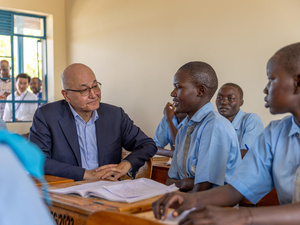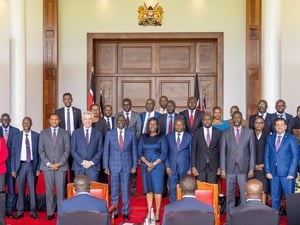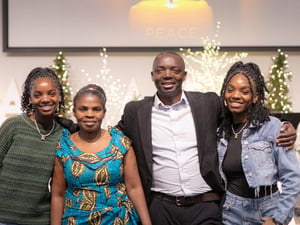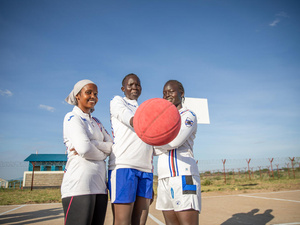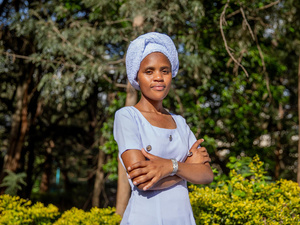Kenya's Dadaab camp swells with Somalis fleeing drought, conflict
For much of her adult life, Shamsa Amin Ali has had to cope with failed rains withering her crops, killing her livestock and displacing her and her family within Somalia. But faced with a relentless drought that has gripped the Horn of Africa region for the past three years, her resilience reached breaking point.
“In previous droughts, we would move to nearby towns and go back when the rains come, but this drought is the worst we have ever seen,” said the 38-year-old mother of ten children from Saakow, southern Somalia.
About 18 months ago, she finally lost hope of the longed-for rains returning and embarked on the long and difficult journey with her children to safety in Kenya.
“We walked for eight days to reach here. There was nothing to feed my children. They would cry and cry and cry,” Ali said. “At some point, I thought of taking my own life instead of watching them die of hunger in front of me.”
Ali's 82-year-old mother said the current drought eclipsed any other she could remember. “I have never experienced this kind of drought. It forced me to flee my country in search of food.”
In the last several years, more than 110,000 Somalis have arrived in Kenya’s Dadaab camps driven by a devastating combination of conflict and drought in search of food, water and safety.
- See also: As the Horn of Africa drought enters a sixth failed rainy season, UNHCR calls for urgent assistance
The Horn of Africa region including Ethiopia, Somalia and Kenya is facing the longest and most severe drought in 40 years. The unprecedented failure of five consecutive rainy seasons is pushing millions of people towards famine.
“Shamsa and her family, like other Somali refugees who have arrived here, are the victims of this mix of toxic elements; climate change, conflict, and displacement,” said Joung-ah Ghedini-Williams, UNHCR’s Head of Global Communications, who visited Dadaab recently.
“They are suffering here because of things entirely out of their control, things that they have not created,” she added.
Guuray Abdi, 68, said she had endured 30 years of conflict in Somalia but there was no way she could withstand hunger. The drought destroyed her family’s crops and killed all their livestock.
"Imagine not being able to feed your children ..."
She described the bones of dead animals scattered across the parched landscape of her southern hometown of Bu’ale like "piles of white stones".
“The drought is worse than the ongoing conflict in Somalia, it made life even more difficult. Imagine not being able to feed your children and they sleep on hungry stomachs,” Abdi said.
“There was fighting in my village. My relative and his son were both killed and his children fled to Ethiopia. But when the drought claimed the last of our crops, we had no choice but to flee to Kenya,” she added.
With the new arrivals, the population of Dadaab has swollen to over 320,000 refugees, putting pressure on already overstretched resources. UNHCR, the UN Refugee Agency, and its partners are struggling to provide much-needed assistance including water, food, health care and other vital services to the most vulnerable, including children who are among the hardest hit.

Guuray Abdi, 68, from Bu'ale in Somalia fled to Dadaab with her son Omar after enduring 30 years of conflict.
“Last December, over 3,000 children under five were treated for malnutrition. Admissions to the paediatric wards have doubled in a year,” said Lorraine Dalizu Ombech, UNHCR’s protection officer in Dadaab.
“Together with partners, we have launched critical child protection services, including high-impact nutrition interventions for pregnant and breast-feeding women, infants and young children. The innocent children of Somalia deserve a healthy start in life. We owe it to the children and women of Somalia, who continue to bear the brunt of the long conflict and cyclical droughts.”
The Dadaab camps were first established in the 1990s to host some 90,000 Somali refugees fleeing the country’s civil war, but have since grown to become one of the largest refugee settlements in the world. Abdullahi Ali was among the first group of refugees who arrived at the camp as a child. He is now 40 and serves as a community leader helping new arrivals to settle in.
“The refugees in Dadaab have gone through so many challenges. But nothing compared to what they are going through today,” Ali said. “Those of us who have been here longer are helping the new arrivals. They need shelter, food, water and health services. We try our best to share what we can with the new arrivals but we can only do so much.”
While those newly displaced like Ali had initially hoped their stay in Dadaab would be temporary, forecasts of a sixth failed rainy season make the prospect of returning to their farms very slim.
“I cannot go back to Somalia because the challenges are still there,” Ali said. “The drought is still there. My farm, animals and even my house have been destroyed, so there is nothing to go back to.”
She added that due to climate change, weather patterns have become more unpredictable. “Sometimes there is rain, sometimes there’s no rain. The weather becomes very harsh.”
“We cannot afford to watch children die of hunger,” said Ghedini-Williams. “The people of Dadaab and the millions of other displaced families in the Horn of Africa region who were uprooted from their homes by climate change deserve assistance and protection. We must come together to do whatever we can to save lives and help communities recover and rebuild.”


